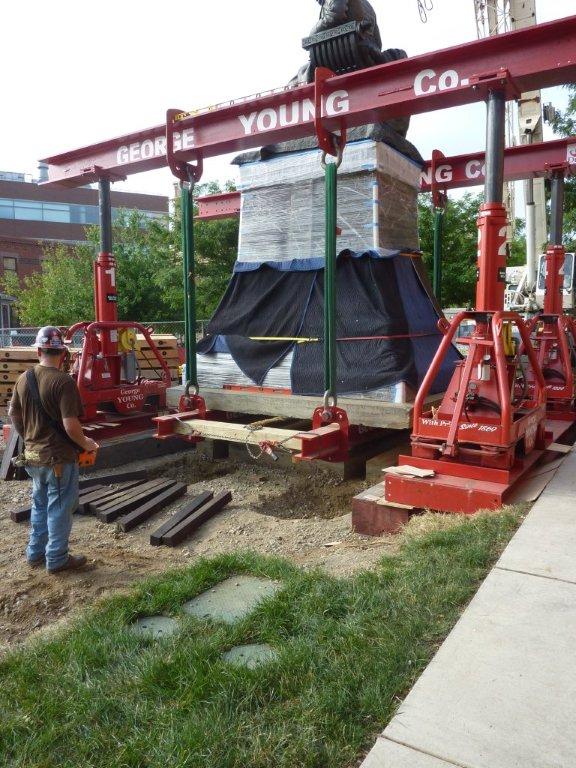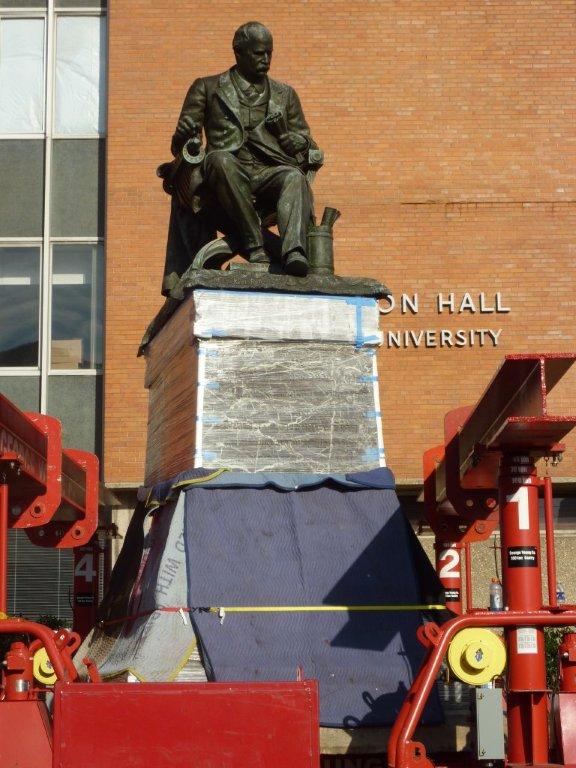


At its Annual Conference, the Specialized Carriers & Rigging Association (SC&RA) announced the winners of the Rigging Job of the Year Awards. George Young Companies, Swedesboro, N.J., won in the Jobs Under $150,000 category for relocating a 103,000-pound historic monument.
When Drexel University recently started an started an expansion project that involved the construction of a new 12-story College of Law, the first challenge was to relocate a 107-year old, 103,000-pound bronze statue of founder Anthony J. Drexel, which sat where the new building would be constructed. A call was made to George Young Companies, an expert in handling fine art and historic monuments, to perform the project.
The effects of time and pollution had taken their toll on the monument’s Italian granite base. Fissures, cracks and broken lettering marred the valuable work of fine art. The monument’s site was ringed with underground subways and above-ground buildings, making the use of a large crane expensive and heightening risk.
Goals were set for the project including implementation of Young Group’s Beyond Zero Safety Program as the project’s No. 1 goal. Protection of the monument’s stone base and eliminating stone loss was considered vital. Soil and ground strength were reviewed and additional loads of crushed stone were installed to provide a stable lifting and skidding surface.
Young’s Heavy Rigging Group reviewed the site and suggested applying their heavy rigging systems to relocate this rather light piece. The decision was made to relocate the monument monolithically as opposed to suffering the stone loss that dismantling and subsequent re-assembly would likely pose.
Prior to handling and rigging the monument for the move, the granite base’s multiple fissures were injected with epoxy to stabilize the stone. Areas where engraved lettering was unstable were fortified with Japanese Tissue, a long-fiber vegetable material. Corners were edged in protective devices to prevent damage from incidental contact. Finally, Ethafoam was placed between the rigging equipment and the monument base to absorb vibrations that might cause fissure to spread.
Due to the presence of subways directly underneath the site, the rigging, lifting and relocation plan called for eliminating the use of heavy cranes. Young’s Heavy Rigging Group opted to utilize in-house rigging systems that could lift the valuable and delicate monument, valued at up to $5 million, without a problem or issue.
The university was able to supply notes to the Young Group from when the monument had previously been moved in 1966 and again in the mid 1990s by George Young Companies. The discovery of notes from the previous move in 1966 were instrumental in the rigging plan.
They were the handwritten notes of George Young’s father, and they explained how he designed the foundation, including a pair of 10-inch square beam pockets underneath the marble base. Since the foundation was covered, the notes presented the only information indicating those pockets existed.
After excavation of the area surrounding the monument, a pair of beams were threaded into foundation pockets below the monument’s granite base. The lower lift beams threaded into the foundation pockets were attached to lift beams supported by one of Young’s 100-ton capacity J&R Engineering hydraulic gantries. The gantry lifted the monument to its new elevation so that a Young Group 400-ton capacity turntable could be placed under the monument’s base and on top of crane mats that had been inserted.
The monument was rotated on the turntable exactly 14.5 degrees to match the new foundation orientation located 60 feet away. After reconfiguration to a four-lift beam arrangement, the hydraulic gantries lifted the monument a second time and Young’s 500-ton Hydra-Slide system was installed under the base.
Multiple eight-foot long custom built skid-shoes allowed for numerous safety cribs to support the lower lift/skid beams and the granite base and easily slid the 103,000 pound monument into final position over the waiting foundation. The J&R Engineering hydraulic gantry performed flawlessly as it lifted the monument for the third and final time, lowering the monument into position after the removal of the Hydra-Slide rail system.
Upon inspection, all of the engineering and precautions taken resulted in a zero stone loss result and a satisfied client. Over the years, the company has handled almost 150 different large works of fine art, many of them multiple times.